Nuances of root care
You can completely save an orchid even when there are only a few roots left. In this case, the order of actions depends on their number and state.
If there are few or no good ones left
When there is only one root left on the orchid rosette, and sometimes only "stumps", the plant can be restored in an ordinary substrate. After removing the rotten parts, the places of the cuts are powdered with Kornevin. Then the orchid is planted in a small narrow pot (6-8 cm in diameter) and placed in a bright place. The temperature of the plant is moderate, since overheating at this time is destructive.

Important! If a peduncle has formed, it is cut off so that all efforts are directed to the formation of healthy roots.
If they're bad and rotten
When all the roots on the outlet are bad or rotten, it is advisable to cut them off completely and restore the plant using one of the methods described above. Pruning old, rotten roots often exposes the rudiments of new ones and allows them to grow. The procedure has a beneficial effect on the condition of the entire plant: it rejuvenates and soon blooms.
What to do with a sluggish root system?
Slightly wilted orchid roots should not be removed from the outlet immediately. There are recovery methods that can bring the plant back to life:
- Transfer to fresh soil. The plant is removed from the pot, soaked in warm water to remove the old substrate. If completely rotten areas are found, they are cleaned and the cuts are treated with charcoal. The new substrate is made from charcoal, pine bark, moss and perlite.
- Watering with softened water. Common ways to improve the quality of tap water are filtration, freezing followed by thawing, settling for 2 days.
- Soaking in soft water. You can also soften the water by adding wood ash (3 g per liter), peat (100 g per liter).
If all recommendations are followed, the orchid will successfully grow new roots and continue to grow and develop.
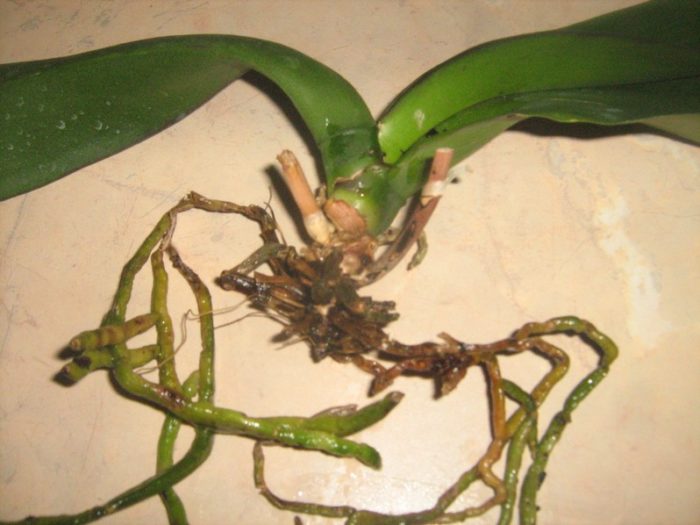
Rooting errors
The most common mistake made by novice orchivores is tearing off a withering leaf. It is impossible in any case to forcibly remove the leaf plates that have begun to die off. The explanation is very simple. A weakened plant cannot use its root system for food, so in order to survive, the orchid begins to pull reserves of nutrients from the lower leaves. By removing them, you greatly reduce the plant's chances of survival.
The next common mistake is the lack of slicing. Wound surfaces that have not been disinfected can become a source of infection with various putrefactive bacteria. If this happens, successful rooting is out of the question.
Also, many flower growers place the orchid in an insufficiently lit place during rooting. At the same time, due to insufficient photosynthesis, the plant begins to experience oxygen starvation. Its result is rapidly increasing cell death and the complete death of the entire orchid.

Causes of root decay
Since there are no seasonal changes in the homeland of the orchid, in our latitudes the autumn-winter period is a very difficult and dangerous time for a flower. At this time, the growth of the orchid slows down somewhat, it consumes less nutrients and water, which, in excess, accumulate in the soil.

The main causes of root rot are most often several factors.
Improper watering of the flower. Excessive watering in the absence of ventilation damages the plant.In regularly wet soil, damage to the root integumentary tissue occurs, which then penetrates deep into the roots. Excess moisture causes rotting of the root system, but at the same time its lack leads to wilting of the plant
Therefore, when watering, it is important to focus on the condition of the soil: watering is carried out only with completely dry soil.
Lack of light. Light is a prerequisite for photosynthesis
With insufficient lighting, the process of cell formation is disrupted. As a result, the orchid stops growing, the roots do not absorb water, begin to rot and die.
Hypothermia. When the orchid is kept in low temperature conditions, the process of moisture consumption is also disrupted. In the cold, excess moisture has a burn effect on the roots of the flower, causing its further death. This happens most often if the plant is kept on a windowsill in winter.
Excess fertilizer. Top dressing of high concentration can also cause burns - chemical. Even small overdoses of top dressing, as well as their application to dry soil, lead to root rot.
Fungal diseases. They can occur when the soil is saturated with moisture. First, withered leaves appear, and then the disease spreads to the roots.
Soil contamination with infections and harmful insects. With a long growth of an orchid in the same soil, ticks and infections can appear in it, which can destroy both the foliage and the roots of the flower.
Dense ground. New, unused soil, consisting of individual components, loose in structure. When filling the pot, it does not fill the container tightly, there is always air between its particles, which allows the roots of the flower to breathe. Over time, soil compaction occurs, which leads to the disappearance of the layer from the air. With a lack of air aeration in a humid environment, the roots also begin to rot.
Mechanical damage to the roots during transplantation. Broken roots must be well treated with disinfectants, otherwise the open root tissue is easily infected with various infections.
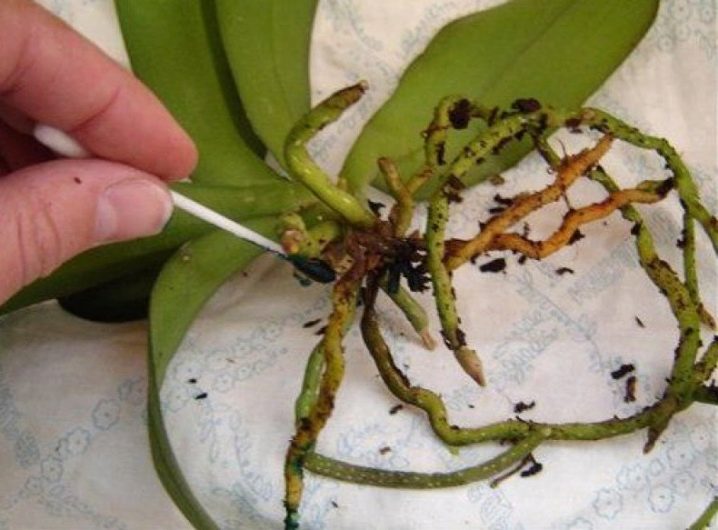
How to save phalaenopsis whose roots have rotted: transplant, as a method of treatment
If the roots of the phalaenopsis orchid have rotted, then it is necessary to transplant the flower into a new pot as soon as possible.
Required process actions
The resuscitation process consists of certain actions obtained by flower growers on the basis of many years of experience:
- The flower is removed from the container and well cleaned of the substrate;
- An examination is carried out to determine the degree of damage;
- Rot damaged, dry and dead roots are cut with a disinfected sharp instrument;
- With numerous pruning, the root system is treated with "Funadzol" or "Topsin";
- All parts of the slices are sprinkled with activated charcoal or cinnamon;
-
With partial pruning of damaged roots, the plant is placed in new soil, with a pot previously disinfected;
- With global or complete pruning, it is placed in a mini - greenhouse;
- The first 7-10 days, watering is excluded, this is necessary to tighten the cut points;
- The container with the transplanted flower is installed in a warm place without direct sunlight.
For Phalaenopsis, 4-6 small roots are enough to supply the plant with moisture.
In the future, with the creation of the necessary conditions and care, the root system will begin to actively develop and return to its normal state.
Disease recurrence risks and how to avoid them
Nothing new has yet been invented to avoid the risks of growing such an exotic crop.
Only by observing proper watering, providing the plant with sufficient light, maintaining the root part in good air circulation, carefully feeding, you can avoid negative consequences during cultivation.
Why do the roots rot after transplanting?
 There may be several reasons for root rotting after transplantation:
There may be several reasons for root rotting after transplantation:
- Not tightened enough after trimming and processing the cuts;
- The decay process has reached the base of the root collar.The phalaenopsis neck rots, and then it is necessary to clean it up to healthy tissue;
- Poor quality or non-disinfected soil;
- Overflow, lack of light and air circulation.
Causes
Damage to the root system often occurs because before that it was simply flooded with water. This is a common mistake of novice florists who think that excess moisture will only benefit a tropical flower. Wet and waterlogged substrates are two different things. Root rot makes the roots brown and soft, and nutrients are no longer delivered to the plant through its food system, which is almost certainly a death sentence for an orchid.
With this system, the roots will remain hydrated, but excess moisture will go away. When the first signs of decay appear, the roots must be removed immediately, since the spreading rate is very high.

Too much water prevents oxygen from penetrating to the roots, hence the unfavorable processes. Leaves will begin to slow down, new ones will appear pleated, and existing leaves will turn yellow.
Is it possible to save a sluggish and damaged flower: recovery methods
How to help grow with a greenhouse?
In the presence of a window greenhouse, in which it is possible to maintain the optimal temperature and humidity level, there is a high chance of reviving the plant. To do this, you need to do the following:
- line the bottom of the greenhouse with expanded clay;
- lay steamed sphagnum moss on it;
- a leaf rosette is placed in the ground.
To grow roots up to 4-5 centimeters, it is necessary to maintain a humidity in the greenhouse, at least 75-95% and a temperature within + 23 ° С, + 27 ° С. The plant should be well lit for at least 12-14 hours a day. If all conditions are met, the chances of recovery are at least 80%.
During maintenance, the greenhouse must be ventilated at night and watered as the substrate dries. If there is no greenhouse, then you can use the tools at hand, for example:
- trimming large bottles;
- confectionery boxes.
The main thing is to create a microclimate inside it in which the plant will recover and develop faster.
How to grow without a greenhouse?
For this, special preparations are used as bait, which give the plant the necessary amount of nutrients due to the absorption capacity of the leaves. The soil is slightly moistened before planting.
In order not to damage the plant, the procedure is best carried out in the morning or in the evening to exclude exposure to sunlight and not cause a chemical burn to the plant. It is necessary to exclude the ingress of bait on the buds and flowers.
How to grow by planting in a substrate?
A substrate is a mixture of various components that is necessary to create a comfortable habitat for a flower, as close as possible to a natural one. Orchids usually grow in trees, absorbing moisture and nutrients from the bark. Therefore, it is necessary to make a mixture that will be lightweight, environmentally friendly and have good drainage characteristics that cannot be obtained in ordinary soil.
The following components are used to prepare the mixture:
- tree bark;
- sphagnum moss;
- ash;
- fern roots.
These components are basic and, if necessary, can be supplemented:
- coconut fiber;
- dry leaves;
- peat.
In some cases, expanded clay is added for better drainage characteristics.
The flower is carefully cleaned of damaged and rotten roots and planted in a prepared pot. After that, you need to carefully monitor the moisture level of the substrate so that it is constantly slightly moistened. You do not need to water the plant regularly so that the water does not stagnate at the bottom of the pot, otherwise the decay process will resume.
The temperature in the room with the plant should be between 23-25 degrees.If the temperature drops below 20 ° C, then the growth of roots will slow down, and the process of reproduction of microbes and bacteria will noticeably accelerate.
How to put into water to form a root system?
How to grow roots in water:
- If the plant is devoid of roots, then to build new organs, some growers recommend placing it in a container with water. In practice, it is not always possible to save a plant with a severely damaged root system, therefore, for a greater supply of nutrients, it is recommended to add a teaspoon of sugar syrup or liquid honey per liter of liquid.
- Another way how to root:
- place the plant above water;
- all rot is thoroughly cleaned, the cut site is treated with activated or charcoal, and left to dry for 8-10 hours in a well-lit room, but without direct exposure to sunlight;
- after which the plant is placed in a glass vessel filled with filtered or boiled water in such a way that the neck does not touch the water, but is at a distance of 2-3 centimeters from it.
During resuscitation, you need to be prepared for the fact that the plant will lose most of the turgor, but this is normal, since this is necessary to compensate for the distribution of nutrients and restore the root mass.
From the video you will learn how to reanimate an orchid without roots in water:
How to stimulate the growth of organs in a child?
How to grow roots in a baby:
- We prepare an aqueous solution with a growth stimulant, where we place the plant cleaned from the old substrate and rot.
- Dissolve a tablet of activated or charcoal in a bowl with boiled water, heated to 23-25 ° C.
- We place the orchid in the basin, where further restoration of the root system will take place.
All this time, it is necessary to maintain good air circulation and high humidity in the room. If a certain amount of water has evaporated from the container, then it is necessary to fill it up to a sufficient level. Only preheated water should be added so that there is no temperature difference.
Nuances and features of development after resuscitation
 Everyone is interested in the question of how long the stem resuscitation can take. I would like to warn you right away that this is a protracted process, it takes from 6 to 12 months to fully recover.
Everyone is interested in the question of how long the stem resuscitation can take. I would like to warn you right away that this is a protracted process, it takes from 6 to 12 months to fully recover.
Wiping the leaves with an aqueous solution with growth accelerators will help speed up the rehabilitation. The procedure can be performed a couple of times a week.
After a successful resuscitation, special attention should be paid to eliminating the root causes that led to the disease. An important point will be regular watering, maintaining the temperature regime and maintaining the necessary humidity in the room.
An important point will be regular watering, maintaining the temperature regime and maintaining the required humidity in the room.
Why is the orchid dying?
An orchid is a plant that came to us from a tropical habitat, therefore significant temperature changes, changes in the length of daylight hours become destructive for it. If in the warm season the flower feels good, even being on the street, then in the cold season inexperienced flower growers have obvious problems with caring for it. If you do not create the right conditions for existence, then very soon you can see how the orchid disappears before our eyes.
To understand what happened and what should be done, you need to inspect the plant and pay attention to:
- deciduous cover - in case of problems with the roots, the flower will have sluggish leaves that will rapidly turn yellow;
- shoots - if there is a yellowing process from the top to the root, then this indicates obvious problems with the health of the flower;
- absence of flowers for a long time - the root dies, it does not have the strength to nourish the buds and give them the opportunity to bloom;
- stable flower growth - a healthy bush grows upright and sits well in a pot with small fluctuations, but if the arrow begins to tilt, and the orchid dangles when the pot moves, then the root system is no longer able to firmly hold the bush in the ground.
To understand whether the root system is alive or not, you should pay attention to the following signs:
- color - live roots are usually light or greenish, while rotten ones become dark, black or brown;
- elasticity - a healthy root has a dense structure, and a dying root becomes soft due to voids inside due to the active decomposition process.
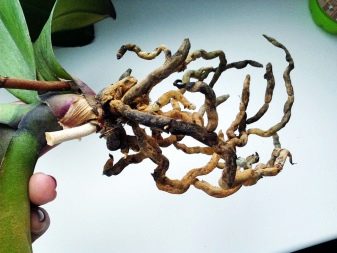
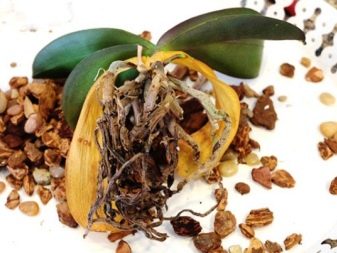
The orchid did not die until it completely dried up, in all other cases there is an opportunity to save it. Among the most common problems with orchids that are found in novice florists are:
- bush without a growth point;
- frozen top;
- an arrow broke;
- leaves wither;
- overflow of a flower;
- a branch broke off;
- the leaves are burnt in the sun;
- I came across a painted orchid.
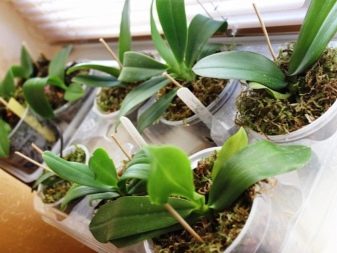
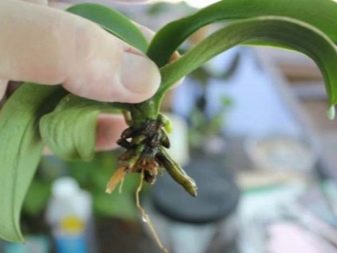
Despite the fact that the problems are quite different, they can be caused by only five factors.
Overheating of the flower. The conditions in which the flower is located must be under control at all times. Leaving your orchid all day in an unventilated, hot room or on a sunny window will overheat. Due to active heat exposure, there is an intensive consumption of moisture, which soon ends, which provokes wilting of foliage and drying of the entire flower. If it was not possible to save the orchid from such a situation, you must immediately start helping the flower by removing it for a couple of hours in a dark part of the room so that the plant will come to its senses
It is very important at this moment not to touch the bush, letting it just rest, and then add water or spray the foliage. It may take from one to two days to fully return to the previous state.
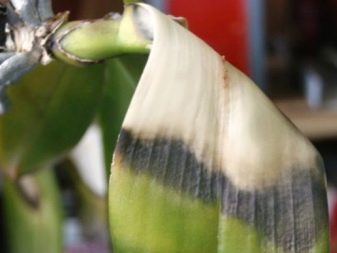
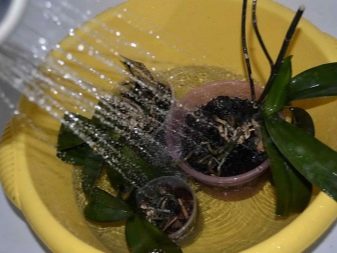
The presence or absence of fertilizers. Any plant that grows in atypical conditions for itself must be supported with fertilizers. Excessive amounts of them will not be beneficial, as instead the root system will be poisoned and the bush will die. To understand that there is too much fertilizer, one has only to carefully evaluate the appearance of the flower. With an overabundance of nutrients, you can see the wilting of the plant, yellowing of the foliage, a change in the color of the roots and their decay. If you notice these signs in time, there is a chance to save the orchid by removing it from the pot, washing out the roots, removing all damaged parts and planting it in new soil.
Decay of roots. In case of obvious changes in the ground part of the plant, it is worth checking the condition of the root system. If she is in order, then the cause should be looked for in something else, but if there are clear signs of death, then it is worth trying to stop this process and save the flower.
The presence of parasites in the soil - most often problems arise with an orchid when parasitic beetles, which are also called click beetles, are introduced into the soil. It is they who become the main reason for the wilting of the root system, as they actively absorb it. To get rid of such a misfortune, you need to remove the flower from the old pot, eliminate the soil, wash the roots and plant it in new soil.
It is important to wait a certain amount of time before applying any fertilizers, otherwise you can poison the roots of the plant, which have not yet recovered from the attack of the beetles.
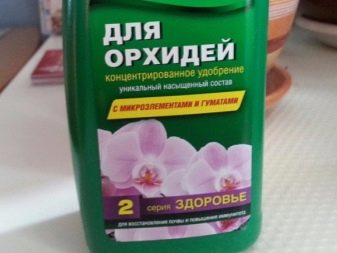
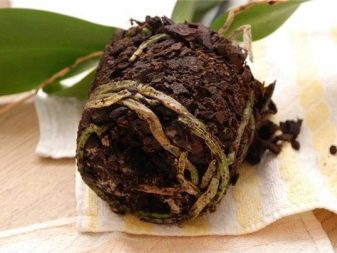
Phalaenopsis resuscitation without roots
Methods
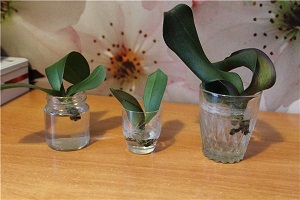 You can completely restore the stem, for this, first determine the cause of the disease and take the necessary measures. Most often, orchids are reanimated, which have no root system at all or it is very small.
You can completely restore the stem, for this, first determine the cause of the disease and take the necessary measures. Most often, orchids are reanimated, which have no root system at all or it is very small.
This can be done in several ways:
in the greenhouse, complete rehabilitation of phalaenopsis without roots is possible. To do this, you will need a transparent container for the greenhouse itself; you can use a 5-liter plastic bottle for this.A layer of wet expanded clay is laid at the bottom of the greenhouse, on top of it is a pillow of wet moss, on which the rehabilitation process will be carried out. The cut orchid with processed and dried sections is placed in the greenhouse directly on the moss, you can tie the stem to the previously washed and boiled bark. The bottom of the plant, where the roots should be, should be submerged in an impromptu pillow
It is important to maintain the temperature regime and regularly ventilate the greenhouse, and then in 1-2 months the roots will appear on the plant;
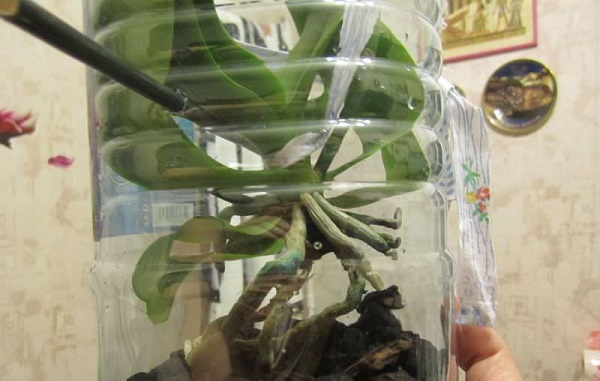
Phalaenopsis resuscitation in the greenhouse.
Important! The moss in the greenhouse must be constantly wet, but not wet!
restore phalaenopsis and without greenhouses, just in sphagnum. This method requires a transparent pot in which the bottom is covered with drainage. The next layer will be wet sphagnum, in which the cut plant stem is placed. The container is transferred to a warm and well-lit place, but direct sunlight should be avoided
It is important to monitor the state of the sphagnum, it cannot be watered, the moistening is carried out from a spray bottle only when the moss dries well;
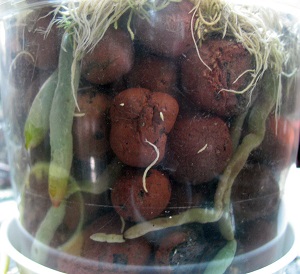
- it is possible to reanimate an orchid on expanded clay, but this is a very time-consuming process. Only experienced florists will be able to carry it out correctly. The main danger lies in the particularity of expanded clay. While wet, it gives off moisture, but as soon as it dries up, it begins to draw water from the plant.
For restoration work, a transparent pot is filled with wet expanded clay, in which the plant is placed. Place in a warm place and monitor the humidity inside the pot;
- You can also revive over a container of water, into which nutrients are added to stimulate root growth. Usually they use a jar or glass filled with water so that the placed orchid does not touch its surface, but is as close to it as possible. When moisture evaporates, the stem will receive the necessary substances for the development of the rhizome.
Each of these methods will help restore a dying plant, but this process can be protracted.
Helper drugs
To speed up the recovery process, a number of preparations are used for phalaenopsis orchids. With their help, the roots of the flower grow several times faster, and the stem itself feels much more comfortable. The most popular among florists are:
- Succinic acid, which is used to build up roots and restore leaves in the idea of a solution. It is prepared from one tablet of the product and a liter of water. Use it in the form of spraying and for watering no more than once a month;
- Vermiculite is a free-flowing fraction that is usually used instead of moss or bark. It is distinguished from the substrate by a large number of useful substances. Germination of roots in vermiculite is carried out by planting a plant in the usual way, only the bark or moss is replaced with a product. Watering is necessary as it dries;
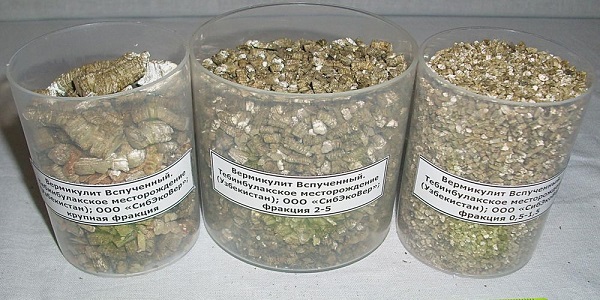
Vermiculite of different fractions.
- Kornevin is a growth stimulant; it is used to germinate the roots of Phalaenopsis directly in water. The powder from the bag is diluted in accordance with the instructions and the resuscitated plant is placed there for 20 minutes. After the lapse of time, the orchid is transferred into a container with water and placed in a bright and warm place;
- Fitosporin will help reanimate phalaenopsis after detecting fungi. In this preparation, the plant is soaked for 15-20 minutes, and then it is planted in a greenhouse or a pot of sphagnum;
- Glucose will become an assistant for all the previous preparations, and it itself will help germinate roots in a diseased stem. The leaves of the reanimated plants are wiped with an aqueous solution, and if the plant is placed in it along the neck, the process of root formation will significantly accelerate. A healing potion is prepared from a liter of water and two ampoules of a pharmaceutical preparation.
Attention! The use of stimulants will speed up the rehabilitation process, but you should not expect quick results, for a plant to fully recover, time and proper care are needed.


